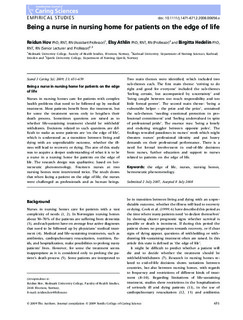| dc.contributor.author | Hov, Reidun | |
| dc.contributor.author | Athlin, Elsy | |
| dc.contributor.author | Hedelin, Birgitta | |
| dc.date.accessioned | 2020-02-20T09:54:12Z | |
| dc.date.available | 2020-02-20T09:54:12Z | |
| dc.date.issued | 2009 | |
| dc.identifier.citation | Hov, R., Athlin, E. og Hedelin, B. (2009): Being a nurse for patients on the edge of life in nursing homes. Scandinavian Journal of Caring Science 23, 651–659. | nb_NO |
| dc.identifier.uri | http://hdl.handle.net/11250/2642821 | |
| dc.description.abstract | Nurses in nursing homes care for patients with complex health problems that need to be followed up by medical treatment. Most patients benefit from the treatment, but for some the treatment seems only to lengthen their death process. Sometimes questions are raised as to whether life‐sustaining treatment should be withheld/withdrawn. Decisions related to such questions are difficult to make as some patients are ‘on the edge of life’, which is understood as a transition between living and dying with an unpredictable outcome, whether the illness will lead to recovery or dying. The aim of this study was to acquire a deeper understanding of what it is to be a nurse in a nursing home for patients on the edge of life. The research design was qualitative, based on hermeneutic phenomenology. Fourteen nurses at two nursing homes were interviewed twice. The result shows that when facing a patient on the edge of life, the nurses were challenged as professionals and as human beings. Two main themes were identified, which included two sub‐themes each. The first main theme: ‘striving to do right and good for everyone’ included the sub‐themes ‘feeling certain, but accompanied by uncertainty’ and ‘being caught between too much responsibility and too little formal power’. The second main theme: ‘being a vulnerable helper – the prize and the price’, contained the sub‐themes ‘needing emotional protection in professional commitment’ and ‘feeling undervalued in spite of professional pride’. The essence was: ‘being a lonely and enduring struggler between opposite poles’. The findings revealed paradoxes in nurses’ work which might threaten nurses’ professional identity and put heavy demands on their professional performance. There is a need for formal involvement in end‐of‐life decisions from nurses, further education and support to nurses related to patients on the edge of life. | nb_NO |
| dc.publisher | Scandinavian Journal of Caring Sciences | nb_NO |
| dc.subject | the edge of life | nb_NO |
| dc.subject | nurses | nb_NO |
| dc.subject | nursing homes | nb_NO |
| dc.subject | hermeneutic phenomenology | nb_NO |
| dc.title | Being a nurse in nursing home for patients on the edge of life | nb_NO |
| dc.type | Journal article | nb_NO |
| dc.source.pagenumber | 651-659 | nb_NO |
| dc.source.volume | 23 | nb_NO |
| dc.source.journal | Scandinavian Journal of Caring Sciences | nb_NO |
| dc.source.issue | 4 | nb_NO |
| dc.identifier.doi | https://doi.org/10.1111/j.1471-6712.2008.00656.x | |
| dc.description.localcode | måsjekkes | |
